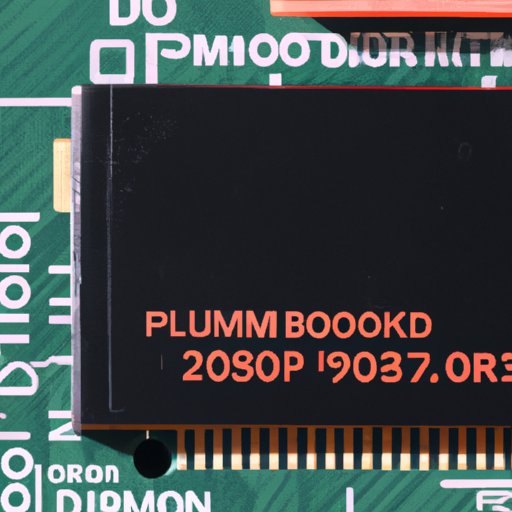Introduction
Knowing your motherboard’s model and manufacturer can be important for several reasons. It allows you to determine whether your PC is compatible with certain upgrades or components, enables you to troubleshoot hardware issues, and helps with driver updates. In this guide, we will walk you through the steps to identify the motherboard you have installed in your computer.
A Beginner’s Guide to Finding Out Which Motherboard You Have
Your motherboard is the main circuit board that connects all the components of your computer. There are different types of motherboards, including ATX, Mini-ITX, and Micro-ATX. The type of motherboard you have can affect the size and compatibility of other components.
Knowing what kind of motherboard you have is crucial because different manufacturers create motherboards with different specifications. These specifications determine how your system operates and what kind of components can be installed.
5 Simple Steps to Identify Your Motherboard Model
Identifying your motherboard’s model is a straightforward process that can be done in these five steps:
Step 1: Look for the manufacturer name on the motherboard
The manufacturer name is often silk-screened onto the motherboard itself. Look closely at the surface of the board for any text that looks like a company name. Some common motherboard manufacturers include ASUS, MSI, Gigabyte, and ASRock.
Step 2: Look for the model number on the motherboard
Motherboard model numbers are usually found printed in white text on the circuit board. Look for a string of numbers and letters that follows the manufacturer name on the board. This model number can typically be found near the CPU socket, PCIe slots, or RAM slots.
Step 3: Look for system information in the BIOS
Accessing the BIOS or UEFI utility can provide you with a wealth of information about your computer’s hardware, including the motherboard model. Reboot your computer and press the key or keys required to enter the BIOS or UEFI utility during startup. Look for a screen that displays system information, which can include the manufacturer and model number of your motherboard.
Step 4: Check your computer’s documentation
If you still have the original paperwork or manual that came with your computer, the motherboard’s model number should be listed. This document may also be available from the manufacturer’s website support section if you have lost the physical copy.
Step 5: Use third-party software to identify your motherboard
If none of the previous four steps work for you, there are several third-party software programs you can use to identify your motherboard. These programs include CPU-Z and HWiNFO, which can provide you with a list of your motherboard’s specifications.
Motherboard Hunt: How to Check and Identify Your PC’s Motherboard
If you’re having trouble finding your motherboard, it may not be visible at first glance. Your motherboard is typically the largest circuit board in your PC, so locating it shouldn’t be too difficult. Remove the cover of your PC case and look for a rectangular circuit board that connects to the power supply and other components like the processor, RAM, and PCIe slots. If you’re unsure of its location, locate the manual for your computer’s model number online and use it as a reference.
How to Figure Out Your Motherboard Model and Manufacturer
It’s important to know both the manufacturer and model of your motherboard as they can determine the compatibility of other components. One simple way to figure out both is to look for the manufacturer name and model number on the board itself, as explained in steps one and two of the previous section. Below are some further tips to identify the manufacturer and model number:
- Look for any stickers on your computer tower or inside your case that might contain information about your motherboard, including its manufacturer and model number. These can usually be found near the back of the case or on top of the power supply.
- Check the original box your computer came in as the model number and manufacturer are often listed on the side of the box.
- Use system information software like Belarc Advisor or Speccy to catalog the hardware on your system and get detailed information about your motherboard.
Unlocking Your PC’s Secrets: Discovering Your Motherboard Model and Specs
Identifying your motherboard’s specs can be crucial to upgrading your system or troubleshooting issues you may be experiencing. Here are some important specifications to note:
- CPU socket: This determines which processors will fit on your motherboard.
- RAM slots: This determines the speed, type, and amount of RAM you can install on your computer.
- PCIe slots: These determine which expansion cards can be installed on your computer, including graphics cards, sound cards, and network cards.
To find detailed specifications about your motherboard, use system information software like CPU-Z or HWiNFO. These programs list the manufacturer, model, and detailed specifications about each component of your motherboard.
Conclusion
Knowing your motherboard’s model and manufacturer can help you with upgrades, hardware troubleshooting, and driver updates. In this guide, we provided a step-by-step process to identify your motherboard and offered tips for identifying the manufacturer and model number. By following these steps, you can unlock the full potential of your computer and ensure that it’s performing at its best.
Always remember to take precautions when handling computer components or accessing the motherboard.
